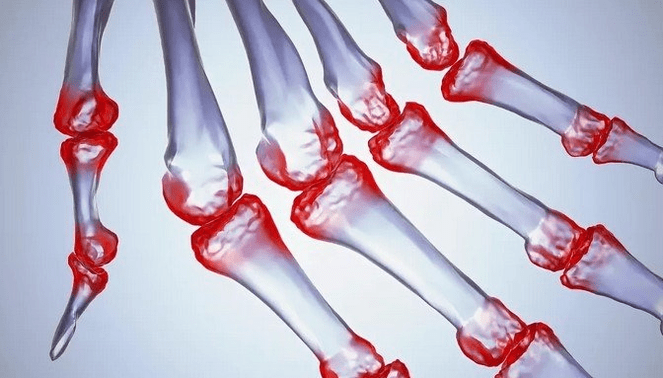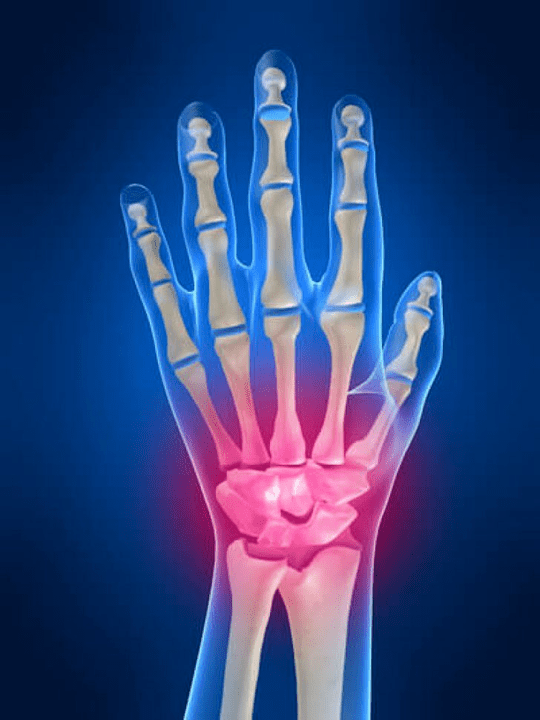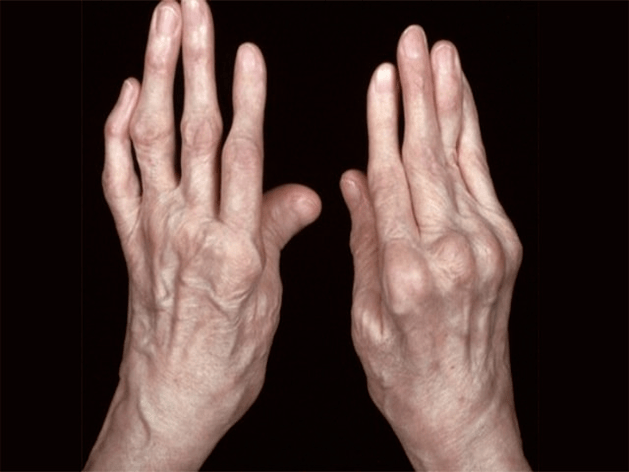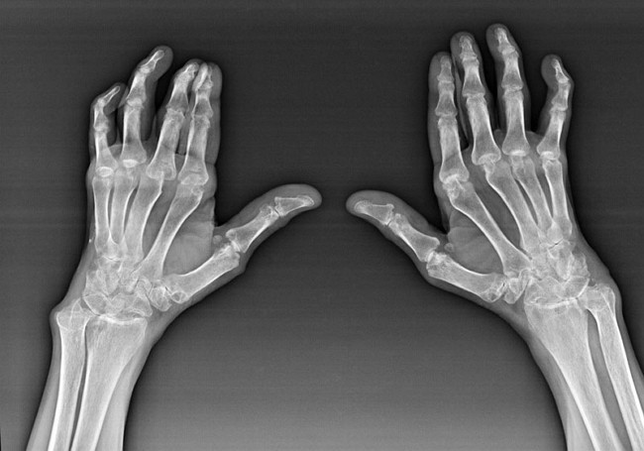
JointFingers are an indispensable sign for any common pathology where the components of the joint structure are damaged.First of all, pain in this joint area can be associated with a variety of autoimmune diseases (Systemic red luster, rheumatoid arthritis, psoriatic arthritis, etc.) where immune factors cause damage to their own articular tissue.
The next main reason to startsoreAt the finger joint, there may be injuries (bruises, dislocations, bone fractures, ligaments).Pain in these joints can also be provoked by degenerative changes that occur in their articular tissue.This is often observed with osteoarthritis.
Anatomy of the joints
All hand joints are the norm to be divided into the following groups:
- wrist combination;
- wrist joints;
- Carpal-pattern joints;
- interpencial joints;
- Parlemonal-phalanx joints;
- Interphalanx joints.
Wrist joint
The wrist joints are formed by proximal bone bone (upper) a number of wrists (Trihedral, half, scaphoid bone) and distal areas of radiation and elbow bones.Elbow bones are not connected directly to the wrist bone, but with the help of distal (Lower) the articular disc.This structure separates the wrist cavity from the distal cavity (Lower) Tile joints.
Wrist joint
The wrist joint is represented by three types of joints.The first form includes a joint located between the upper bone (scaphoids, semi -moon, trihedral, nuts) or the bottom line (shaped hooks, heads, trapezoids, bones-tricked).These joints are called interchangene joints.With the second type, the middle joint is listed.These joints have S -shaped shapes and are formed due to the upper and lower bone connections of the wrists.The third type includes peanut bone joints.Through this joint, the trihedral bone is connected to the bone.
Cotton-cotton joints
Carpal-panel joints connect the wrist and metacarpal bone.These joints are formed by proximal end contact (excuse) The metacarpal bone and the distal part of the karpal bone belong to the second row.Carpal joints include two main joints.The first is the carpal play joints from the thumb.It is formed with the first metacarpal bone connection with the bone-catches.
The second connection is along with the usual carpal path for the entire karpal-prypyna compound between the second, third, fourth, fifth and trapezoid bones, head bones and, in part, bone section.Carpal joints of the thumb pattern are separated from the amount of carpal catet.Because more active movements may be in it, compared to the entire karpal path (that is included in the general karpal passage joint) that is considered inactive.Karpal panel joints are reinforced by strong articular capsules, as well as ligaments (back ligaments and palmar).
Interpret the joints
The second, third, fourth and fifth bone surfaces, when contacted by each other, form the interprox joints.These joints have separate articular capsules, which approach the carpal-joint joint capsule, connected to them.In addition to the capsules, these joints have ligamentous tools represented by the metacarpal ligaments between the ligaments, as well as the back and palmar ligaments.Interpener joints are associated with inactive joints, as the articular surface of the bone that forms the joints -this is a flat shape.
Parleen-phalanx joints
Parleus-phalanx joints are a distal compound (lower) with the tip of the metacarpal and proximal bone (upper) The first area of the finger.Each upper finger has its own metacarPonal joint.Therefore, there are five phalancing metacarpal joints in each hand.
Interphalanx joints
Interpophalanx joints are formed by a combination of neighbors each finger.LargeFirst) The finger has only one interfalced joint, as this finger has only two phalanx (proximal and distal).The rest of the fingers -each hand has two interforancing joints.
The first is the local one (the firstproximal) and the second (average) fingers and called proximal phalanges (upper) Joint Interphalang.The second forming the relationship between average (second) and the last (distal) Fingers.The second interphalangeal joint is called distal interfalced joints.Inter -phalanx joints are reinforced with collateral and palmar ligaments.These joints belong to the block joints, which may be only around the frontal aircraft (Struggle and bend).

What structure can be inflamed in the joints?
Inflammation is a feature of typical pathological processes of tissues and organ damaged for any reason.Keep in mind that, in most cases, every disease (For example, gout, rheumatoid arthritis, etc.) or trauma that damages the joints of the hand to one degree or the other, not only affects the articular, but also the perioster (nerves, muscles, tendons, subcutaneous fats, skin) structure.
The following articular structures can be inflamed in the joints:
- cartilage together;
- Squeezing bone tissue;
- Capsule together;
- Ligaments together.
Causes of pain in the joints of the hands and fingers
The main part of the causes of pain in the joints and fingers are occupied by mechanical injuries (Broken, dislocation, bruises, etc.) and systemic autoimmune diseases (Rheumatoid arthritis, systemic lupus erythematosus, psoriasis, etc.).In addition to these reasons, pain in the joints can cause disease related to metabolic disorders (For example, gout, osteoarthrosis).

There are the following main causes that cause pain in the joints and fingers:
- hand and finger bruises;
- fracture of the brush;
- brush dislocation;
- Ligament wounds;
- rheumatoid arthritis;
- Kinbek disease;
- reactive arthritis;
- gout;
- psoriatic arthritis;
- Synovitis;
- osteoarthrosis;
- The Red System Lupus.
Brush bruises and fingers
Bruises are one of the types of closed injuries, where there is damage to the soft tissue (muscles, tendons, nerves, skin) And there are no wounds in the main action of the traumatic factor directed.The soft tissue bruises of the hand and fingers are very rare separately (separately) from bruises of joints and fingers.Therefore, with this type of injury, mixed symptoms are found, showing both damage to the joints, and periarticular lesions (Peri -human) cloth.Brush bruises and fingers are usually found when falling in the hands, damaging them with blunt objects, with compression or pinching.
Frequently, the bruises of the cyst zone cause damage to the median, radial, elbow nerve (elbow nerves (that absorbs the area of the hand and finger), which is immediately indicated by the loss of skin sensitivity, and in some cases even losing the function of the finger motor.
Inflammatory edema of the articular structure and peri -Humans developed by the development of various vessels that they supply blood.This edema is one of the inflammatory reactions, which occurs in response to damage to the tissue during bruises.
Break the brush bone
Often, the cause of pain in the joints can be a variety of bone fractures, as these bones continue to register in the formation of articular surfaces.Depending on the position of the bone anatomy, all fractures are divided into three main groups.The first group includes wrist fractures.The second includes a tube metacarpal fracture.The third group includes a fracture of the finger.
The most common places of damage in the carpal zone of the brush are semi -moon and scaphoids.One fracture occurs during the fall on the brush and is accompanied by pain in the wrist and moderate wrist joints.Pain syndrome can also be observed in places of localization of bone anatomy.
The most frequent fracture on the tip of the metacarpal bone is the first metacarpal bone fracture (that is attached to the thumb bones).With these injuries, edema and pain appear in the first metatarsal bone zone, as well as in the carpal-shaped part of the joint, which is directly adjacent to it.Thumb with such a broken fracture, bent and lead to the palm of your hand.The movement is limited.
The brush phalanx fractures are accompanied by deformation, decreased finger length, loss of function, sharp pain and swelling in inter -phalanx and peri -human tissues.With a fracture of a finger with a displacement of bone fragments, palpation (on the palpation) You can identify them stand out on the surface of the brush palmar, and in the back, on the other hand, holes or isolation.These fragments are usually mobile, near them, you can often detect subcutaneous bleeding (hematoma).
The brushing of the brush
Dislocation is a pathological condition in which bone areas that make up any joints go beyond the anatomical boundaries, which, thus, is characterized by complete or partial loss of the joint.In addition to the function of the joints affected during dislocation, severe pain in the affected joints, swelling, and increased local temperature are also found.During the brush dislocation, the appearance of swelling is explained not only with the presence of inflammation in damaged peri -human tissue, as well as the structure of the joints, but also with the highlight of the derivative joints.
The most frequent type of brush dislocation
| Name | Mechanism | Which joints are amazed? |
| A true brush dislocation | The articular surface of the wrist bone is transferred compared to the surface of the radial bone to the palm of the hand or behind the hand. |
|
| Grievance | The wrist and the rest of the brush are switched compared to the lunch and the radial behind the brush. |
|
| Felling | At the same time, the scaphoid bone displays the displacement of the radiation in parallel (In the same plane) to the bone near the wrist.Sometimes it can switch to the palmar side, that is, to switch to the bone palm, less often on the same side of the trapezoid bone. |
|
| Half -time crashes | There was a half slipping towards the palm of the hand, so that the space in the bone was not busy.It is gradually occupied by the head of the head, penetrating here from the second row of the wrist.This loss is a self -complication -the rules of the perilunar. |
|
| The first metacarpal bone | The basic articular surface of the first metacarpal bone shifts compared to the articular surface of the bone-trapped in the radiation, rising (rising (proximal) and in the same plane as the wrist bone.Therefore, the thumb is pulled slightly and toward the combination of the wrist. |
|
| Finger Fashion | There is a finger dislocation in the metacarpophalangeal joints and between-phalanx joints.Initially, the surface of the proximal phalanx joints of the finger (Together -She with the rest of the fingers) Switch compared to the articular surface of the metacarpal bone.With the second, there is a shift between the bone of the finger itself.There are usually back dislocations and palm oil from the finger falanges. |
|
Damage to hand ligaments
Ligamen wounds together with brush bruises due to closed traumatic damage.This pathology is mainly found with an extension of the hand, the fingers to the direction.The main types of wounds of a group of brushes are stretching and breaking.With stretching in the damage zone, slight voltage and partial rupture of connective tissue fibers are observed.With ligaments breaking, the entire ligaments are divided into two endless ends.
The main types of broken ligaments of brushes are distinguished:
- rupture of the wrist radial collateral ligaments;
- Rupture of wrist elbow collateral ligaments;
- breaking the ligaments;
- rupture of the ligaments of the phalancing metacarpal joints;
- Rupture of the ligaments of the interphalang joints.
Rheumatoid arthritis
Rheumatoid arthritis is a disease in which the human immune system damages its own body tissue.In other words, rheumatoid arthritis is an autoimmune pathology.The disease is also systemic, as many tissues are affected by it (muscles, joints, vessels, etc.) and organ (Heart, kidneys, lungs, etc.) in the body.
Although rheumatoid arthritis is a systemic disease underneath, at a larger level, the joints suffer, while tissue and other organs are in the background.With this disease, almost all types of brush joints can be affected (wrist, karpal path, metacarpal-phalanx, inter-phalanx joint).The wound is usually symmetrical (them.The same joints are affected) In both hands, accompanied by swelling, pain in damaged joints.In the morning, while lifting from bed, there are some stiffness in the affected joints, which can last about 1 hour and then disappear without a trace.
Usually with rheumatic arthritis near the affected brush joints (More often piano-phalanx, inter-phalanx joint) Rheumatoid nodules appear.They are a round formation located under the skin.On the brush, this formation arises most often behind.On palpation, they are dense, inactive, painless.Their numbers can vary.
Kinbek's disease
Kinbek's disease is a pathology in which the semi -brush bone is affected.The disease develops as a result of the long physical advantages of the palm.It usually occurs in construction professional specialists - plaster, mason, combination, and other.Excessive physical activity from the palm of this bone is most often, as it occupies a central position on the wrist combination.Often, during Kinbek's disease, one hand brush is affected and, as a rule, the main (The right hand is broken, the left hand is damaged).
Reactive arthritis
Reactive arthritis is a pathology of the genesis of immunopathological, in which its own immune system attacks various joints in the body, so autoimmune inflammation develops in it.Unlike other autoimmune diseases (For example, rheumatoid arthritis, systemic erythematosus lupus, in which its origin is assumed) In reactive arthritis, a clear relationship between infection is detected (and, in particular, intestines or urogenital) and the development of joint lesions.
Also, with this pathology, lymph nodes can increase and fever appear.When the transition of reactive arthritis to a chronic form, over time, the patient may show signs of kidney disease, heart, and muscle atrophy, bursitis may occur (Inflammation of the periosemantal bag), tendovaginites (Tendon vagina inflammation) and others.
Gout
Gout is a disease based on the development of uric acid accumulation in the body and its deposition in the form of salt in the joints.Uralgic acid is a final product of the basic metabolic purine and pyrimidine.They serve as the basis for the construction of DNA and RNA molecules, some energy formations (Adenosine trifosphate, monophosphate adenosine, etc.) and vitamins.
Pain with gout occurs mainly in the lower and upper leg joints.In addition, in 50% of all clinical cases, the disease begins with joints coupled with feet.On the hand, as a rule, the joints between the fingers are affected, less frequent - radiant joints.Gout usually damages one or more joints in one member of the body, sometimes -sometimes the joints are involved in the inflammation process.
Psoriatic arthritis
Psoriatic arthritis is a pathology in which various joints are inflamed to the background of psoriasis.The development of psoriasis is based on a violation of the interaction between immune cells and skin cells as a result in the body (and especially on the skin) There is an autoimmune reaction that causes inflammation.
Synovitis
Synovitis is an inflammation of the synovial shell joints, accompanied by damage to the tissue and the accumulation of pathological fluid in the affected joints.Synovitis is not a separate disease, but serves as a complication of other diseases.It can occur with endocrine pathology, allergies, contagious, autoimmune, brush, etc.
Osteoarthrosis
Osteoarthritis is a disease in which there is a violation of the formation of common cartilage tissue in various joints.These processes are violated under the influence of certain external and internal predisposing factors.They can be persistent joint injuries, prolonged physical activity (At work, in everyday life, during sports), descendants, other joint diseases, etc.
Finger joints with this pathology, because in periarticular (Peri -human) The tissue occurs inflammation, the nerves are affected.Characteristics of osteoarthritis are pain connections with physical activity.Joint pain mainly appears on and/or after heavy physical load and disappears at rest or after rest.
The Red Lupus system
The systemic lupus erythematosus is an autoimmune pathology, in which in the human body there is the production of autoimmune antibody systems, attacking various cell and tissue structures.In particular, the production of anti -antibodies that damage the nucleus of cells and DNA and RNA molecules are observed.With red lupus, various fabrics and organs - skin, vessels, heart, pleura, pericardium, kidneys, joints, etc.
The red lupus of the system is always associated with other additional signs - weakness, weight loss, fever (Increases body temperature).However, special symptoms are very important, without the diagnosis of red lupus is not made.This special sign is photodermatitis (Inflammation of the skin under the influence of sunlight), Discoid rash (Appearance on the skin of the neck, red chest), Lupoid -Rama Rama (The appearance of red spots on the skin near the nose), erosion in the oral cavity, kidney damage (Glomerulonephritis), Serosites (Serous membrane inflammation) and others.
Diagnosis of causes of pain in pain

Hand pain in the joints is involved in the diagnosis and treatment of the cause of pain, especially the traumatologist and the reproductive doctor.To diagnose the causes, the doctor uses clinical (Collection of anamnesis, external inspection, palpation, etc.), radial (Radiography, computed tomography) and laboratories (General blood tests, biochemical blood tests, etc.) Research methods.
Depending on the cause of pain in the joints, all diagnostics can be divided into the following parts:
- Diagnosis of a traumatic injury of the brush (bruises, dislocations, bone fractures, ligaments);
- Diagnosis of rheumatoid arthritis;
- Diagnosis of kinbek disease;
- Diagnosis of reactive arthritis;
- gout diagnostics;
- Diagnosis of psoriatic arthritis;
- Diagnosis of synovitis;
- Diagnosis of osteoarthrosis;
- Diagnosis of systemic erythematosus lupus.
Diagnosis of traumatic brush injury
When a brush injury, you should consult a traumatologist.The main method of diagnosis used in medical practice to identify traumatic damage to the brush (broken, dislocations, ligaments, bruises), is an external examination, anamnesis, research method (Radiography, computed tomography).
Anamnestic data collection allows doctors to identify incidents that can or may cause injury to the brush.The history of anamnesis is also used to explain the symptoms that interfere with the patient.During the external examination of the brush, it is possible to detect swelling, hematoma, deformation, joint mobility limitations.With the help of palpation, doctors reveal the presence of pain, violations of the anatomical form of the joint, damage the ligaments.Radiation research method (Radiography, computed tomography) They allow you to confirm the diagnosis, as during its use, mechanical damage to the formation of brush anatomy is clearly visible.
Pathological treatment that causes inflammation of the joints

For the treatment of the causes of pain in the joints of the hands and fingers, the doctor, first of all, prescribes various medications (Anti -inflammatory, painkillers, anti -Rhevetas drugs, etc.).In some cases, they combine the use of this product with physiotherapy procedures.Traumatic damage to brushes is most often treated by surgery or applied to the upper limbs affected by the gypsum bandage.
To relieve pain and relieve inflammation, the first aid may use an external NSAID.Drugs are selective that prevents COO-2 and acts directly on the source of pain.It is quickly absorbed thanks to the special texture, leaving no trace of clothing, having a pleasant odor.
Depending on the pathology that causes inflammation in the joints, all treatments can be divided into the following parts:
- Traumatic injury treatment of brush (bruises, dislocations, bone fractures, ligaments);
- Rheumatoid arthritis treatment;
- treatment of kinbek disease;
- reactive arthritis treatment;
- Gout treatment;
- treatment of psoriatic arthritis;
- treatment of synovitis;
- treatment of osteoarthritis;
- Treatment of systemic erythematosus lupus.






















